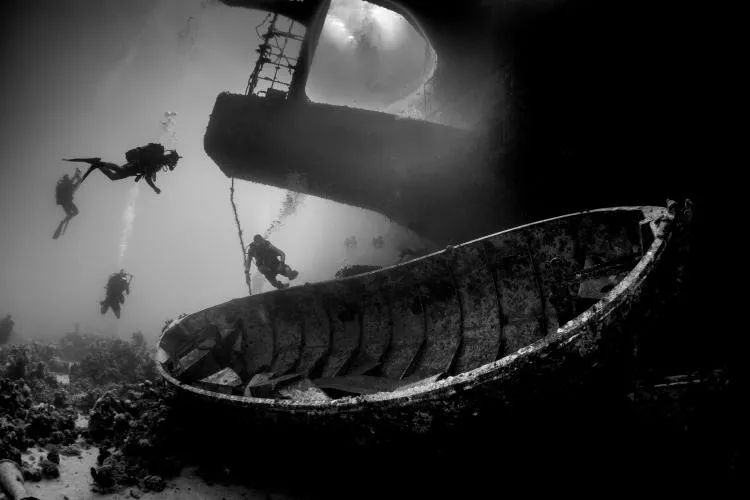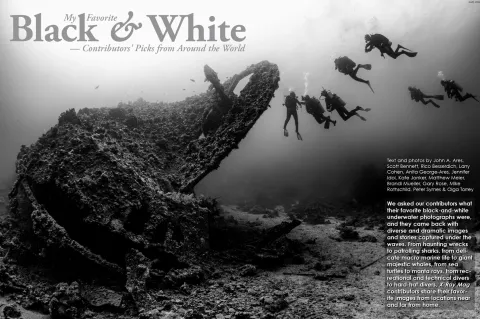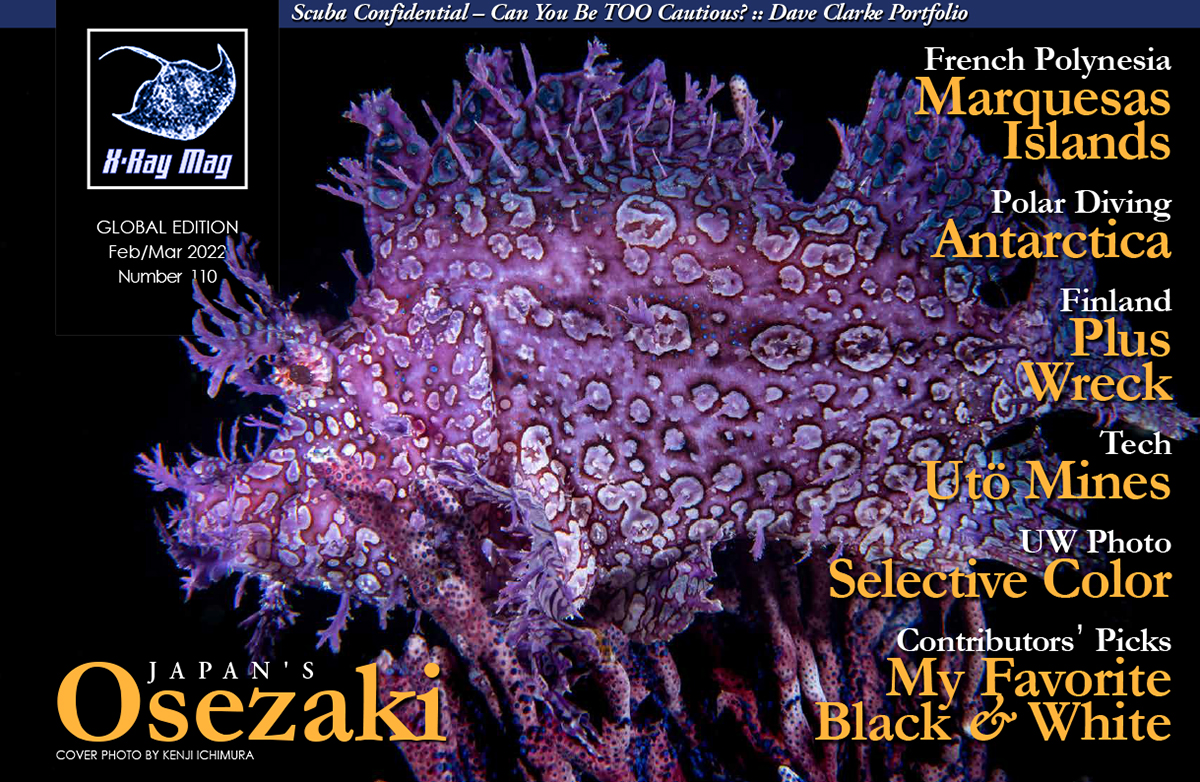We asked our contributors what their favorite black-and-white underwater photographs were, and they came back with diverse and dramatic images and stories captured under the waves. From haunting wrecks to patrolling sharks, from delicate macro marine life to giant majestic whales, from sea turtles to manta rays, from recreational and technical divers to hard-hat divers, X-Ray Mag contributors share their favorite images from locations near and far from home.
Contributed by
(To see all images, scroll down to the end and download the full article PDF)
Textures, Shadows & Contrasts
Text and photos by Kate Jonker
The textures, shadows and contrasts in black-and-white photos are what first drew me to photography as a child. I spent hours using my father’s Canon film camera trying to capture the textures in nature. As an underwater photographer, I love capturing colour contrasts and have had to train my eye to look for black-and-white photo opportunities.
Nowadays, when I see extreme light and texture contrasts in my subjects, I like to capture these for black-and-white conversions. I picture the image in my mind and how it would render with light and texture contrasts. I will then take the raw file into Lightroom where I will convert it to black and white as a starting point and then adjust the sliders just enough to create an image with impact.
The incredible detail in wrecks can be emphasized by converting the image to black and white, but I like to look for contrast in other subjects too, such as schools of fish, sharks and macro subjects. Visit: katejonker.com
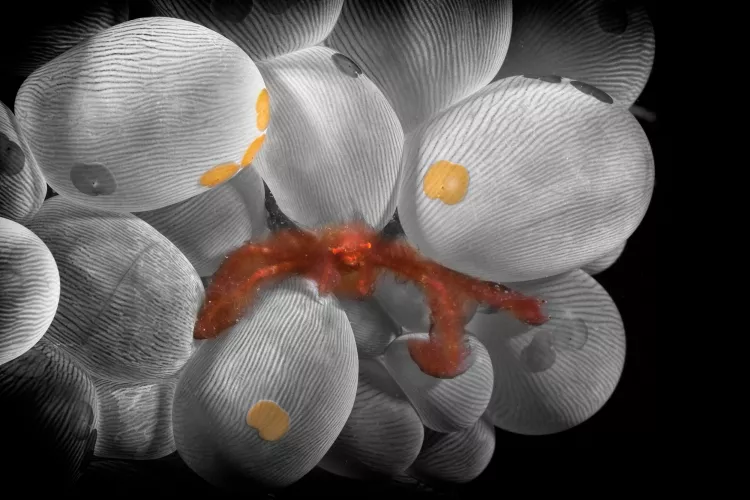
Black and White with Selective Color
Text and photos by John A. Ares
Bubble coral is inherently plain and is an ideal candidate for black-and-white (B&W) photography. Bubble coral routinely hosts colorful creatures like the orange orangutan crab and yellow flatworms, which makes it a prime candidate for the technique of B&W with selective color. I decided to leave several flatworms in B&W to add some interest to the background.
Manta rays are ideal subjects for B&W conversion since they have no other coloration. The night shot was perfect for B&W, except that the lights on the bottom were inherently warm and begged for a selective-color treatment, providing a nice, subtle contrast.
The damselfish was colorless except for the stunning metallic eyes. A pure B&W conversion was a “nice” low-key picture, but using selective color made it compelling.
A fish’s eyes can be quite dazzling. This high-key image of a porcupinefish was enhanced by using selective color. To do selective color, one must master two techniques: first, B&W conversion (of which there are several methods); and second, Photoshop layer masking.
I use Nik Silver Efex software on all B&W conversions because of the unique “structure” slider that adds mid-tone contrast. For a step-by-step walkthrough of how to do selective color, please see my article in this issue entitled, “Selective Color.” Visit: JohnAres.com
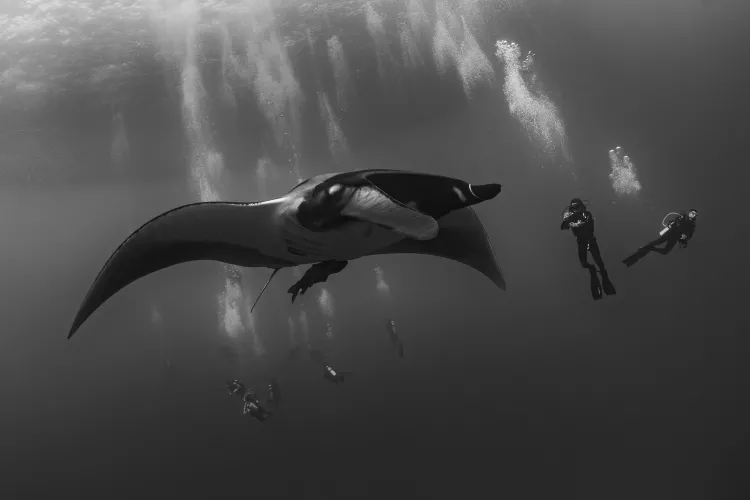
Form, Texture & Tone
Text and photos by Scott Bennett
For me, photography is usually all about colour, with coral reefs and reef fish being one of my favourite subjects. Sometimes, however, an image can be more successful in black and white. Without colour to rely on, an image is reduced to the basics: form, texture and tone. Combined with a strong composition, these factors can create a powerful image not readily apparent in colour.
On a recent liveaboard trip to Mexico’s Socorro Islands, manta rays were the main attraction. A 15mm fisheye lens worked well, but the subject had to be very close. A 16-35mm lens provided more versatility, but the mantas were usually photographed in open water. Even with strobes, images were predominantly blue. Black and white made the subject pop, with background divers creating depth and their bubbles adding contrast.
One of Socorro’s signature sites is Roca Partida, a remote seamount that is usually a magnet for huge numbers of fish. During our visit, things were quiet. Using a 15mm lens, I decided to focus on the seamount itself. Filling the foreground with the wall, patterns and textures lead the eye to the divers in the distance, creating a sense of scale.
Featuring all sorts of shapes and textures, wrecks are another prime candidate for black and white. Situated off Bodrum in Turkey, a Dakota C-47 aircraft provided numerous photography options. Due to the plane’s size, twin strobes can only brighten the foreground, but with colour lacking, this is not an issue.
During summer, whale sharks congregate around the island of St. Helena in substantial numbers. However, guidelines are strict; snorkellers must remain 3m away from the sharks, and strobes are not allowed. A fisheye lens captures the entire subject, while the white spots and rough skin textures contrast sharply with the radiating sunbeams in the water. Visit: xray-mag.com/Contributors/Scott-Bennett
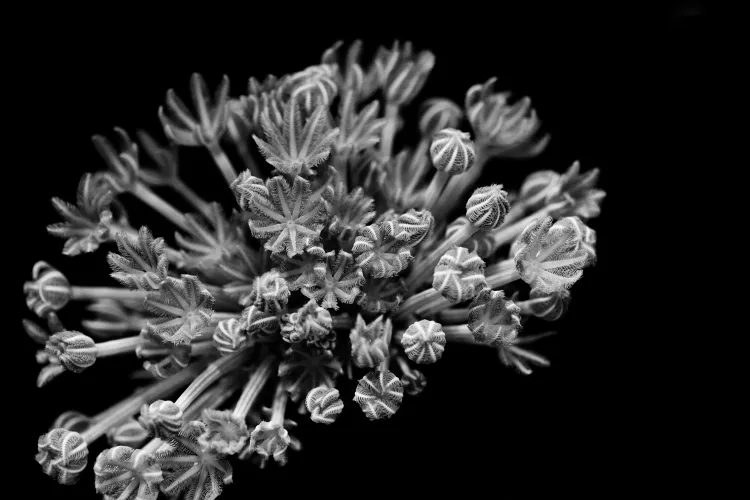
Capturing Aesthetic Aspects
Text and photos by Rico Besserdich
During my first visit to Sharm El-Sheikh, Egypt, to dive the Red Sea, the dive guide pointed to a very tiny spot at the dive centre’s house reef. Folks used to call this spot “Little Ras Mohammed,” a small reef structure of around 5m by 2m, which was stuffed with life. I fell in love with the pulsating xenia soft corals here. I could watch them forever. Their simple beauty and detailed structure inspired me to take a black-and-white shot of them, which, despite being 12 years old, still remains one of my favourite black-and-white shots.
Compared to the Thistlegorm wreck in the Red Sea, the Dunraven (also in the Red Sea) is not a super-great wreck to dive. But it is huge (81.6m)! The image of this wreck is special to me because it is an underwater panorama that consists of four images stitched together. It was a bit tricky to do while hovering freely underwater, so I was happy to carry that shot back home with me.
The model in the image on the right is Olivia. She was a divemaster trainee at a dive centre where I conducted a photography workshop. She was very keen to model for me, so one early evening after my daily classes, we entered the shallow waters of the bay and did a 20-minute shoot. Olivia was a natural. Doing this shot in black and white nicely draws attention to the tiny details and aesthetic aspects of this image and the model. Please visit: maviphoto.com
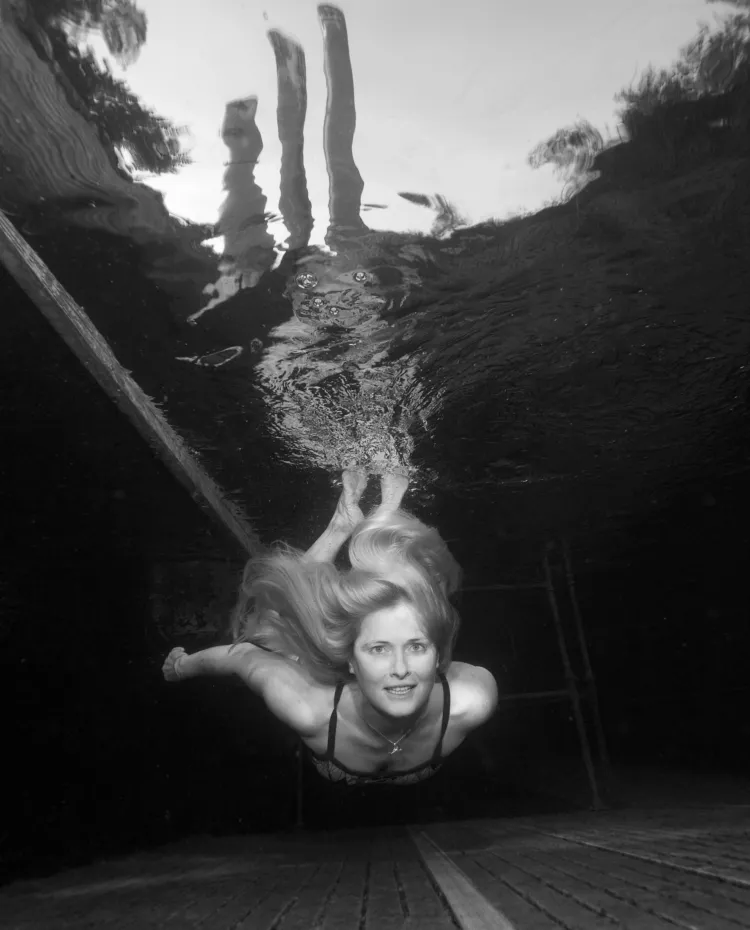
Shades of Gray
Text and photos by Larry Cohen
Most people are used to viewing underwater images with vibrant colors. However, at times, converting the images to shades of gray can produce a striking photograph. If you cannot get close enough to your subject for the strobes to bring out the color, it might also be better to create the image in black and white (B&W).
The silhouette image of the shark and boat captured in Cuba looked flat with a blue background. I did turn off my strobes for this image. Converting the image to B&W added drama to the picture.
To create the photograph of my dive buddy, Olga Torrey, freediving at Dutch Springs in Pennsylvania, USA, I had to balance the strobe light with the ambient light. Capturing in the background the leftover smokestacks from when the site was a working limestone quarry on the surface added interest to the image. Converting the image to B&W gives the image a vintage feel.
When I captured the image of the hawksbill sea turtle in Cozumel, Mexico, I used an 8mm fisheye lens on an Olympus Micro Four-Thirds format camera. I was so close to the turtle that my dome almost touched its nose. I used a 1/100s shutter speed and an f/10 aperture to darken the background. Converting the photo to B&W brought out the texture in the image.
When diving in Cuba, I saw free-swimming remoras for the first time. The image was captured during the day, but I used a fast 1/250s shutter and closed the aperture down to f/16 to create a black background. The original image lacked color, so I converted it to B&W. Visit:
liquidimagesuw.com
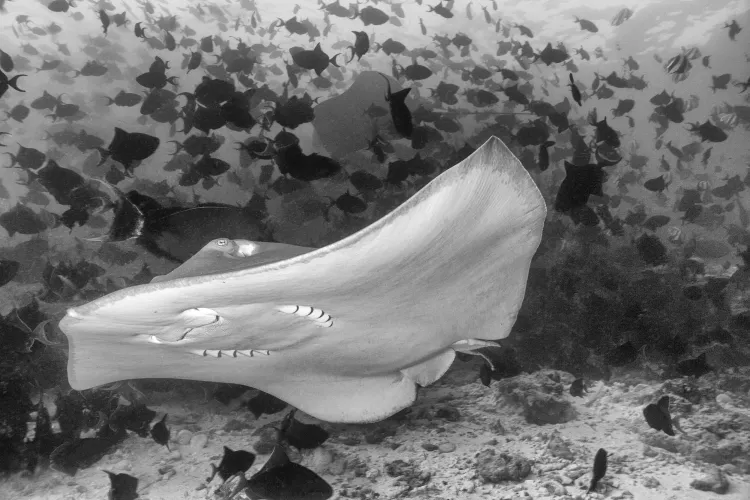
Humpback, Shark, Sea Turtle & Whipray Encounters
Text and photos by Anita George-Ares
The light rays penetrating the water column were not obvious in my original blue water image of the humpback whales. As if swimming with whales was not magical enough, the conversion of the image to black and white gave the appearance of the mother and calf floating above a sunburst.
I shot the image of the shark from another shark cage. The videographer was stepping back as if he wanted to put as much distance as he could between himself and the approaching shark. I like the size comparison between man and shark. The shark was missing the tip of a pectoral fin, which made it easy to identify her during several encounters.
The layers in the image of a hawksbill sea turtle make it one of my favorites. In the background, ripples on the water surface resemble clouds behind the turtle. Chromis and damselfish form the middle layer. The hawksbill sea turtle is featured prominently in the foreground.
Abundant and diverse fish species converge upon the Fish Factory dive site in the Maldives, following the daily dumping of fish waste. I like the Jenkins’ whiprays present in the foreground and background with the school of red-toothed triggerfish in the middle ground. Jenkins’ whiprays repeatedly crashed into me during the feeding frenzy.
All the images were converted to black and white using Nix Silver Efex Pro 2 and Adobe Photoshop CC 2018 software. Please visit my Facebook page at: facebook.com/profile.php?id=100016947967639

A Monochromatic Art Form
Text and photos by Jennifer Idol
Silhouettes and monochrome images are obvious candidates for black-and-white photography, but it takes more than redefining color photography to create a black-and-white image. The best photos not only master composition, but they also transform light into an array of contrasts.
In the digital realm, I am primarily a color photographer but recall my roots in school where black-and-white processing provided parameters for my first photos. They were terrible photos, ruined by pattern, with no discernible subject.
Later, I was fortunate enough to meet one of the greatest champions of underwater black-and-white photography—Ernie Brooks. He built a career on nuances in his images, and supported and educated photographers through his institute of photography. He generously supported my work through his encouragement and was a legend with tremendous depth of character and insight, often remarking on the beauty of 1/125s at f/11.
In honor of Ernie, I share these treasured black-and-white moments. I first share an image of another underwater photography giant, David Doubilet, as he looked up at the sun while demonstrating framing in a silent and treasured moment.
Another is of one of my favorite subjects, the paddlefish, which I photographed in the US state of Tennessee. I timed my dive beneath the fish to capture this silhouette shot. On open circuit, this also meant holding my breath repeatedly.
Lastly, I share a Snell’s-window look at a Texas spring near home, shot in 1/125s at f/11. In the spirit of Ernie Brooks, keep sharing stories from the heart. Visit: uwDesigner.com
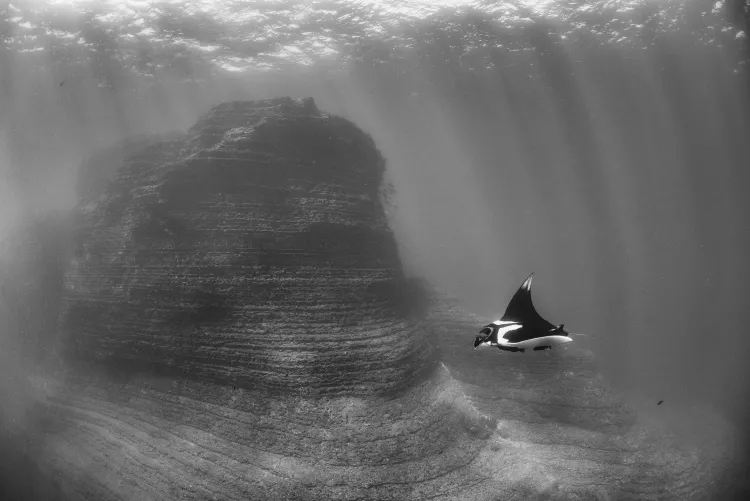
Full Tonal Range
Text and photos by Matthew Meier
My favorite black-and-white photographs include the full tonal range, from bright whites to deep blacks, which helps to create an impactful image, bursting with contrast. While going through my photo library, I was particularly drawn to images with sun rays and one or two strong subjects. The elimination of color simplifies the composition so that the success of the image is defined by its shape, texture, light and shadow detail.
All of my recent photos were originally shot in color and later converted to black and white in postproduction. The conversion process provides an extra bump of contrast, which can elevate a good image to a truly stunning work of art.
While my underwater photography journey began with film, I never mastered shooting and processing black-and-white film to achieve the results I can now produce with Lightroom and Photoshop. I stand in awe of one of my mentors, Ernie Brooks, who created most of his spectacular underwater image collection from rolls of medium format, black-and-white film and just 12 exposures per dive! That said, I will continue to strive to create images that may one day be worthy of being hung alongside the masters. Visit: MatthewMeierPhoto.com
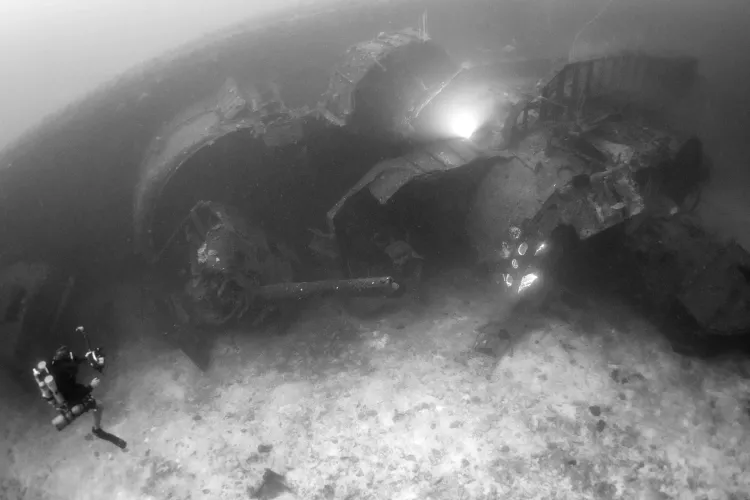
Deep Shipwrecks
Text and photos by Brandi Mueller
I love taking black-and-white images of shipwrecks, especially wide-angle shots. Seeing a ship underwater is like a glimpse into the past—be it a moment frozen in time due to the untimely sinking of the ship, or if the ship was sunk on purpose for an artificial reef, a monument that was otherwise going to be disposed of in disrepair.
I like how black and white can help portray a feeling of time passing, especially in the case of WWII wrecks. Most of the images we see of WWII are black and white, so it seems appropriate to show them in their underwater resting places in the same manner we picture them here.
While the images are taken in the present day, they represent something many years old, and I like the way black and white helps to capture this sense of age. Many shipwrecks are deep, and light is lost, so black-and-white photography can also help show detail and contrast in low-light situations. Please visit: brandiunderwater.com
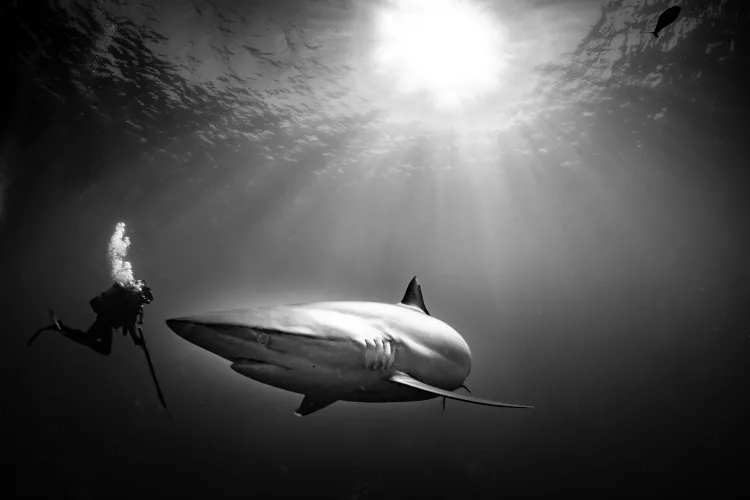
Why Black and White?
Text and photos by Gary Rose, MD
Early pioneers of photography were limited to black and white, or sepia, as they attempted to record people, places, events and emotions. To this day, black-and-white photography is still superior in its ability to evoke visceral emotion.
The photo entitled Gray Scale inspires awe and reverence. The cathedral lighting and broad utilization of grayscale emphasize the beauty and majesty of this regal great hammerhead shark.
The photo which I have titled Hitchcock draws us to the confusion and plight of the diver in this dark and sinister “sharknado,” reminiscent of Hitchcock’s film, “The Birds.”
I particularly like the lighting of the photo that I titled Face to Face. It is the emphasis of the sunburst, and the corona of light reflected from this sandbar shark, that has produced the most “oohs” and “ahs” from viewers, when I have exhibited this photo with other black-and-white photographs.
The photo, Heavy Metal, speaks for itself. Appearing right out of the heart of darkness, this 14ft tiger shark graphically displays its power. As a black-and-white photo, the beauty of the shark’s reflective metallic skin is totally captured.
All divers are enamored with the cacophony of color witnessed on almost every dive. Our left brain works hard to take it all in, analyze it, and then process what we are seeing. It appeals to our objective consciousness. At times, it can be overwhelming. By using black and white, we permit the right brain to absorb and feel emotions contained within a photograph. It appeals to our subjective subconsciousness and evokes a strong emotional response. Visit: garyrosephotos.com
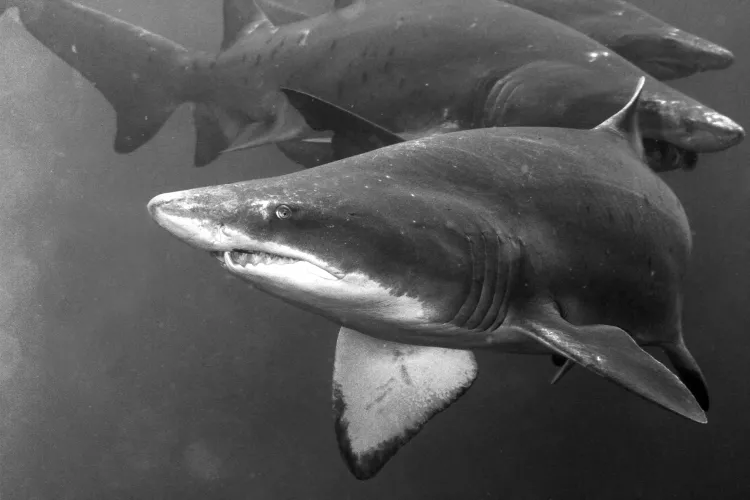
Engaging Tension & Dynamics
Text and photos by Michael Rothschild, MD
Underwater photography is often about the brilliant colors of marine life. But I am drawn to the incredible power of black-and-white images, and for some subjects, this is a far better way of engaging the viewer.
Strobe-lit macro shots show rich, vibrant hues, but the water column between the photographer and larger subjects mutes the contrast of the scene. It washes out details, and beyond usable strobe range, results in muddy ambient-light scenes. By using black and white, contrast and punch are restored. Composition and framing once again take precedence. I find these photographs far more rewarding than the lucky discovery of a flashy nudibranch, where evolution did all the design work for me.
The photo of the freediver is one of my favorite portraits. The black-and-white image accentuates the angles of the freediver, the tension of the breath hold, and the path to the surface.
The photo of the sand tiger sharks is a distance shot with a macro lens. I was planning on shooting little critters when these sand tiger sharks cruised by. I love the way the lens compression makes the sharks look so stocky and powerful.
The Lady Luck wreck photo uses black and white to draw attention to the diver cruising over the wreck, adding a 3D effect to the shot. And in the Stolt Dagali wreck photo, monochrome highlights the diver over the wreck’s rich marine life cover. The taut anchor line keeping the dive boat above firmly in place describes tension and power, like in the image of the freediver, adding dynamics to a still photo. Visit: dive.rothschilddesign.com
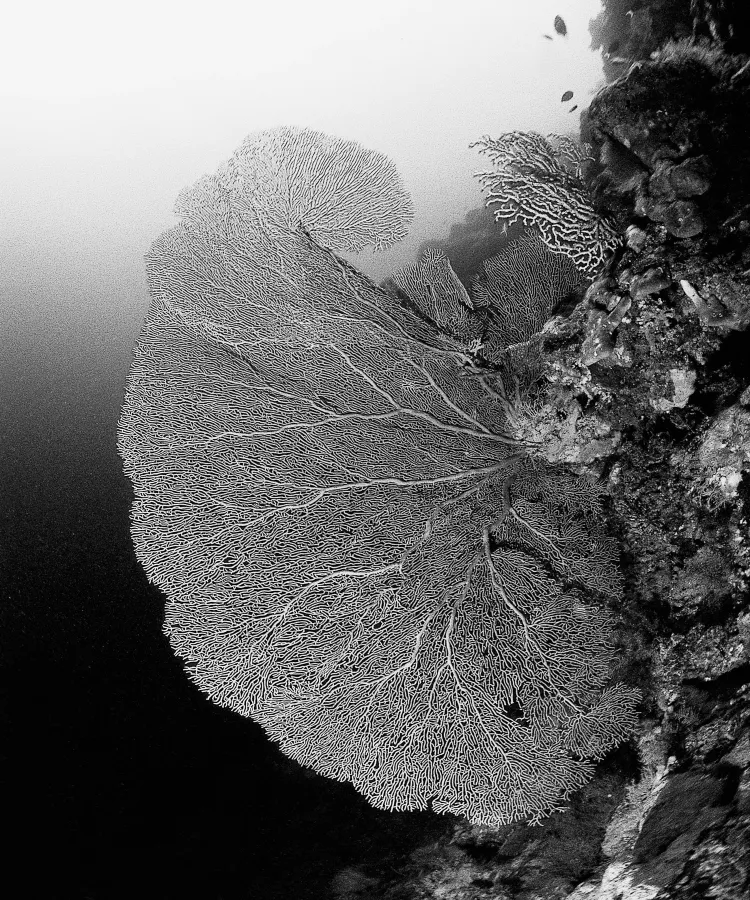
Shooting with Black-and-White Film
Text and photos by Peter Symes
Often a black-and-white image is a converted colour image that is lacking in colour or got it wrong. In some cases, such as in images of wrecks where it is impossible to light up the whole subject, resorting to black-and-white conversion often works quite well and can add an old-school press photo, documentary-quality to the image—if done right.
The image of the gorgonian, however, was taken on black-and-white slide film (Agfa Scala), which I really fancied, until I switched to digital. It was also one of those rare instances in which I just instantly saw the resulting image before my inner eye. I was swimming along the reef, scanning for subjects to photograph when, suddenly, I came across this majestic gorgonian with its delicate structure.
I immediately slammed on the brakes, hovered, eyeballed the distance, and manually adjusted the output of my two flash strobes. It was all just second nature and muscle memory in those days. It came out exactly as I wanted.
The image of the barracuda swirls, on the other hand, is an example of a subject for which strobes were of little use. By composing vertically and tilting upwards, I strived to create an image akin to a walk in a forest with an overhanging canopy. The light filters through the schools of fish as if through foliage and one has to look up, above one’s head, to follow the action.
Because of the rather old technology used, the dynamic range was challenging to get right. It is not quite there, and a modern top-end camera would surely have produced better results—but you get the idea.
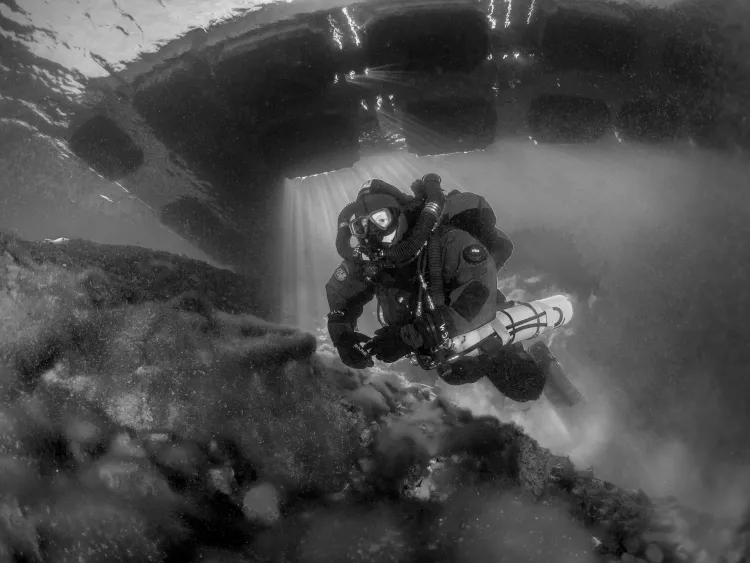
Creating More Drama
Text and photos by Olga Torrey
As much as I enjoy showing the colorful underwater world, sometimes converting an image to black and white (B&W) creates more drama. Usually, I capture images while scuba diving, but I was snorkeling when I took the photo of the blue shark off Montauk, New York. Working in shallow water, the picture looked good in color. However, converting it to B&W created more emphasis on the shark’s white underside.
The image of my dive buddy, Larry Cohen, was captured at Dutch Springs, Pennsylvania. At this dive site, there are platforms set up for training. So, I set up Larry under the platform to get the streaming sunray effect. I then balanced out the ambient light with my strobes. Converting the image to B&W added more drama.
The Challenger 600 airplane is one of the main attractions at Dutch Springs. So, I decided to break the “always-shoot-up” rule and shoot straight down on the plane while Larry and Gregory Borodiansky descended down to the dive site. I found the image more appealing in B&W.
The North East Diving Equipment Group meets at Dutch Springs twice a year and allows sports divers to try surface supply diving helmets. In addition, this fun event provides many fantastic photo opportunities. Unfortunately, taking photos is not easy since the divers walk on the bottom, kicking up silt. However, I did manage to get a silt-free picture of a diver in a classic Mark V helmet rig. Converting the image to B&W made the photo look like a period piece. Visit: fitimage.nyc

